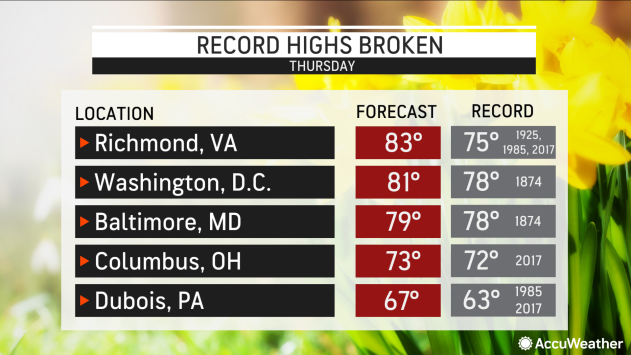Earliest spring in 40 years blooms amid record warmth in parts of US
Millions of people from Texas to New York are experiencing their earliest spring in decades as temperatures remain well above historical averages -- a pattern that AccuWeather predicted a day before Punxsutawney Phil called for six more weeks of winter.
This week alone, dozens of daily record highs were shattered from the south-central to southeastern and mid-Atlantic United States as unusually warm weather surged across all three regions. Blistering temperatures gripped places in the Southeast, including Jacksonville, Florida, which hit a record high of 88 degrees Fahrenheit on Thursday. That broke the old record of 85 F set in 1962.
Some locations even set new record high temperatures for all of meteorological winter (Dec. 1-Feb. 28), including Raleigh, North Carolina, which soared to 85 F on Thursday, surpassing the old record of 84 F set on Feb. 26, 1977. Nashville, Tennessee, also recorded a high of 85 F on Thursday, which set a new monthly and meteorological winter record. The old record was 84 F set on Feb. 13, 1962.
The record temperatures have helped plants to start budding and flowering weeks ahead of schedule, including bluebonnets in Austin, Texas, a city that is experiencing its earliest spring in 40 years. As of Feb. 22, Austin was experiencing its ninth warmest start to the year on record based on maximum temperature. The city typically averages a high of 64 degrees through Feb. 22, but this year has averaged 67.4 degrees, the highest since the record of 70.8 degrees was set in 2017.
Typically during this time of year, leaves would have just started growing on trees in Norfolk, Virginia, based on the 30-year average from the USA National Phenology Network. But this year, the sprouting of new leaves has already spread north to Washington, D.C., and Philadelphia.
In Washington, D.C., cherry blossoms are beginning to bud. An indicator tree for the city's cherry blossoms was already undergoing the first of six stages in bud development a few weeks earlier than usual, according to the National Park Service (NPS).
A park-goer works on a crossword puzzle while sitting in the sunshine during an unseasonably warm day in Providence, Rhode Island, Friday, Feb. 10, 2023. (AP Photo/David Goldman) |
The early taste of spring has even expanded as far north as New York City, where leaves are appearing a remarkable 32 days earlier than what is typically seen. Temperatures across the Big Apple have been significantly above average since the start of 2023, with high temperatures reaching up to 20 degrees above the historical average on some days in February. All four major weather stations in New York City are recording the warmest year-to-date on record, with New York Central Park observing average temperatures nearly 10 degrees above the historical average.
Other cities across the country have been experiencing record warmth to start the year, including Pensacola, Florida, and Atlanta, Georgia, where temperatures through Feb. 22 have been among the top five warmest starts to the year on record. Atlanta observed a temperature of 81 degrees on Feb. 22 -- the highest temperature ever recorded for the city during meteorological winter, which runs from Dec. 1 to the last day of February.
Signs of early spring have surged from the Southeast and Gulf Coast states all the way to the mid-Atlantic, according to the USA National Phrenology, which creates a "spring leaf index anomaly" map. The maps showcase what areas of the country are experiencing leaf growth and how early or late the greening is compared to historical records.
"We create those maps using a long-term data set of lilac and honeysuckle flower that dates back to the 1950s," ecologist Alyssa Rosemartin told AccuWeather National Reporter Bill Waddell.
The map showed the earliest spring on record for locations across the south-central and northeastern U.S, as of Feb. 23. A large swath of the country is experiencing an earlier spring than usual, with the only exceptions being portions of California, Nevada, Arizona, Texas and New Mexico.
Spring Lead Index map for Feb. 23, 2023. (Source: USA National Phenology Network, www.usanpn.org) |
While the unusual spring has resulted in an early bloom for plants that can result in a lengthened growing season, it can also have dire consequences since many areas experiencing the early warmth are still prone to a freeze.
"Peaches growing in Georgia might have leafed out or put out blooms, and if those get hit by a killing frost, there's a significant damage to that crop," Rosemartin explained.
AccuWeather long-range forecasters believe there is a risk for a frost and freeze later than normal across a large area of the eastern U.S., including many areas that have reported early budding and blooming of plants.
The trend of milder winters and early springs can also result in more rodent and insect issues for crops because they can go through more life cycles in a year, according to experts.
"Not every year are we going to see an early spring," Rosemartin said, "it's just more likely with climate change, that we're going to see a warmer winter and earlier spring."
An earlier spring can also pose health impacts to millions of Americans who suffer from allergies.
Additional reporting by AccuWeather National Reporter Bill Wadell.
Want next-level safety, ad-free? Unlock advanced, hyperlocal severe weather alerts when you subscribe to Premium+ on the AccuWeather app. AccuWeather Alerts? are prompted by our expert meteorologists who monitor and analyze dangerous weather risks 24/7 to keep you and your family safer.



